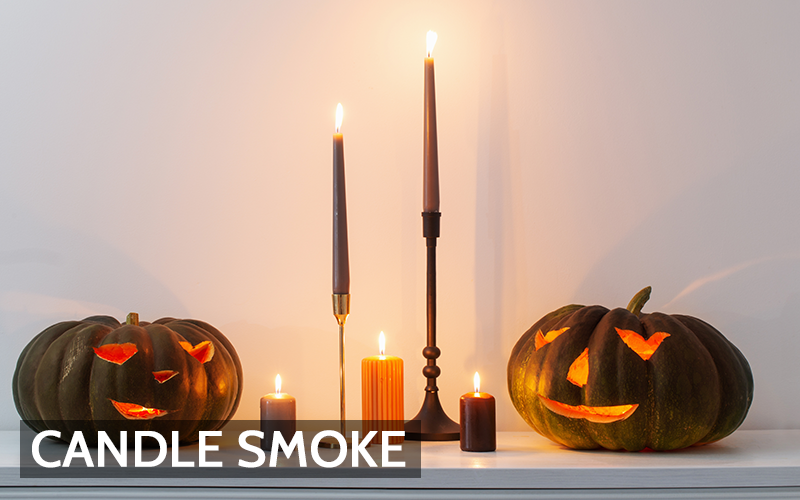Candles have long been a popular way to add warmth, ambiance, and pleasant scents to our homes. As awareness around indoor air quality grows, however, The impact of candle smoke on the air we breathe indoors becomes a question. This article explores the effects of candle smoke on indoor air quality,discussing exactly happens when you burn a candle and providing tips on how to minimize any negative impacts.
What Happens When You Burn a Candle?
When you light a candle, the heat from the flame causes the wax to melt and then vaporize. This process releases a variety of compounds into the air, including tiny soot particles, volatile organic compounds (VOCs), and in some cases, trace amounts of potentially harmful chemicals like benzene and toluene. These compounds, particularly from candles made with paraffin wax, are combustion byproducts and can affect indoor air quality by increasing particulate matter and certain airborne chemicals.
Candles made from alternative waxes such as beeswax or soy, tend to emit fewer pollutants. This is why these types of candles are often preferred for people concerned about indoor air quality. They’re considered to be “cleaner-burning” because they produce less soot and emit fewer VOCs.
Particulate Matter and Soot in the Air
One of the most noticeable effects of burning a candle is the release of soot, which gives the flame its bright yellow hue. Soot is made up of tiny black carbon particles that can linger in the air and settle on surfaces like walls, furniture, and HVAC filters. Inhaling soot particles over a long period may affect respiratory health, particularly for those with conditions like asthma or other respiratory sensitivities.
The amount of soot and particulate matter released depends largely on the type of candle. For example, paraffin wax candles tend to produce more soot than candles made from soy or beeswax. Synthetic fragrances in scented candles may also contribute to an increase in particulate matter.
Volatile Organic Compounds (VOCs) and Other Chemicals
Burning candles, especially scented ones, release VOCs. These organic compounds are what give candles their fragrance profile, but they can also react with other indoor pollutants to create secondary pollutants contributing to poor indoor air quality. Common VOCs found in candles include limonene, benzene, and toluene, which can irritate the respiratory tract at higher exposure levels. However, studies indicate that the levels produced by occasional candle burning are generally low and unlikely to pose a significant health risk.
For a cleaner scent, consider choosing candles made with natural essential oils rather than synthetic fragrances. These candles may release fewer VOCs, reducing their potential impact on indoor air quality.
How Candles Generate Their Scent Profile
The delightful scent of candles comes from the fragrance compounds mixed into the wax, which are released into the air as the wax melts. When burned, the heat from the flame vaporizes these fragrance molecules, dispersing them into the air. Some candles are crafted with essential oils, which can offer a more natural fragrance. Others use synthetic fragrances, which can vary widely in quality and composition.
While synthetic scents may create a more powerful aroma, they can also increase the amount of VOCs released. If you’re sensitive to strong smells, choosing unscented candles or candles made with plant-based essential oils can provide a milder scent and may be less likely to irritate the respiratory system.
Improving Indoor Air Quality While Enjoying Candles
If you enjoy burning candles but want to reduce their impact on indoor air quality, there are a few simple steps you can take:
- Choose cleaner-burning candles: Opt for candles made from natural waxes like soy or beeswax, which produce less soot and emit fewer pollutants than paraffin.
- Ventilate the room: When burning candles, ensure there is adequate ventilation. This can help disperse any particles or chemicals that may be released.
- Limit burning time: Avoid burning candles for prolonged periods, as this increases the concentration of airborne particles. Shorter sessions can help keep indoor air quality stable.
- Trim the wick: A trimmed wick (about 1/4 inch) will produce a smaller flame and, in turn, reduce soot emissions.
Final Thoughts: Candles Are Safe to Burn Indoors
While it’s true that candle smoke does impact indoor air quality by releasing particles and certain chemicals, moderate use in a well-ventilated space is generally safe. The comforting ambiance of candles and the joy they bring far outweigh the minimal risks associated with occasional use. By making mindful choices—such as opting for natural waxes, trimming wicks, and avoiding overly fragranced varieties—you can enjoy your favorite candles with peace of mind.
So, light that candle, relax, and know that with a few simple precautions, you’re taking steps to keep both your indoor air and your esthetic ambience just right.


